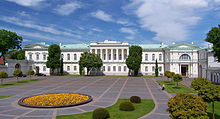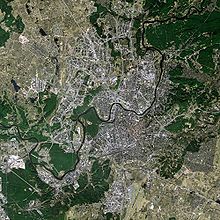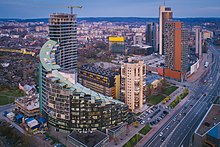Vilnius
![]()
The title of this article is ambiguous. For other meanings, see Vilnius (disambiguation).
Vilnius [ˈvʲɪlʲɲʊs] ![]() , German Wilna (Polish Wilno, Belarusian Вільня Wilnja, Yiddish ווילנע Wilne, Russian Вильнюс Wilnjus), is the capital of Lithuania. With 588,412 registered inhabitants (2021), Vilnius is the most populous city in the country and the largest city in the Baltics in terms of area (401 km²). It is a city (Lithuanian miestas) and a municipality (Lithuanian miesto savivaldybė). The municipality also includes the town of Grigiškės. There were 634,428 residents registered in the municipality's health facilities (76,988 people or 13.81% more than in the registration office) as of 31 July 2019.
, German Wilna (Polish Wilno, Belarusian Вільня Wilnja, Yiddish ווילנע Wilne, Russian Вильнюс Wilnjus), is the capital of Lithuania. With 588,412 registered inhabitants (2021), Vilnius is the most populous city in the country and the largest city in the Baltics in terms of area (401 km²). It is a city (Lithuanian miestas) and a municipality (Lithuanian miesto savivaldybė). The municipality also includes the town of Grigiškės. There were 634,428 residents registered in the municipality's health facilities (76,988 people or 13.81% more than in the registration office) as of 31 July 2019.
Vilnius is the seat of the Roman Catholic Archbishopric of Vilnius and, with Vilnius University founded in 1579, one of the oldest university cities in Europe. In 2009, it shared the title of European Capital of Culture with the city of Linz.
Vilnius was a Baltic foundation from the beginning and, unlike the capitals of the neighbouring Baltic countries, Riga in Latvia and Tallinn in Estonia, was never controlled by the Teutonic Order. As the capital of Lithuania, it developed into the centre of a vast empire which, at the height of its power around 1618, stretched for a time from the Baltic to the Black Sea as Poland-Lithuania.
Since its founding, Vilnius has been considered one of the most liberal cities in Europe, offering protection to persecuted Jews from Central Europe and Russia, among others, throughout its history. As the "Jerusalem of the North", Vilnius became the centre of Jewish culture and enlightenment. Around 1900, Lithuanians made up only a small part of the population (2%), after Jews (40%), Poles (30%) and Russians (20%). As a result of the Second World War, the city lost the majority of its inhabitants (Poles were expelled and Jews fled or were murdered in the Holocaust) and was then virtually repopulated by Lithuanians and Russians. This completely changed the social structure of Vilnius.
From the 16th century onwards, Italian master builders created numerous Baroque buildings in the city. The Old Town of Vilnius is one of the largest in Eastern Europe and was declared a UNESCO World Heritage Site in 1994. Due to the more than 50 churches in the city, Vilnius also bears the nickname "Rome of the East".
In a 2018 ranking of cities by quality of life, Vilnius ranked 81st among 231 cities surveyed worldwide.

Play media file Vilnius walking tour (2011)

Presidential Palace in Vilnius

Satellite view
.jpg)
The reconstructed castle of the Grand Princes
City name
According to its multi-ethnic and multicultural character, the city is known by different names. European maps and descriptions used the name Vilna or Vilna from the 14th to the 20th century. The oldest attested forms from the 14th century read vor die Wilne, ante Vilnam or similar. In Lithuanian it is called Vilnius, and this name - first attested around 1600 - is gradually gaining acceptance in other languages in the present.
The name of the town is derived from that of the Vilnia river (often diminutive Vilnelė), which flows into the Neris not far from the historical centre of the town on Gediminas Hill. The Lithuanian words vilnìs and vilnelė mean "wave" and "small wave" respectively. Moreover, an alternative name of the Neris is *Velija, attested c. 1230 as Велья. The name of the smaller tributary was originally a diminutive of this name.
The asteroid of the inner main belt (3072) Vilnius is named after the city.
Function as capital
In addition to its current function, Vilnius also had a historical one, with a chequered history as a capital. From 1569 to 1795 it was the capital of the Lithuanian Grand Duchy in the Polish-Lithuanian noble Republic of Abiejų Tautų Respublika (Poland-Lithuania or Republic of Two Nations).
Due to the Third Partition of Poland and Lithuania, respectively, both lost their independence completely and Vilnius lost its former capital function, which the city, apart from an interruption from 1918 to 1922, only regained in 1945. With the annexation into the Russian Tsarist Empire at the time of the partition, Vilnius became the headquarters of the Administrative 1795 to 1830 of the Lietuvos Generalgubernatorija (Lithuanian General Government) and then from 1830 until its dissolution in 1912 of the Vilniaus Generalgubernatorija (Vilnius General Government). Within the two general governorates, the city also functioned as the central administrative seat of the respective gubernia, whose name or geographical location changed several times, in which Vilnius was located, e.g. the Vilniaus gubernija (Vilnius gubernia/governance).
After Lithuania regained its independence (see ↑ Independence since 1918), Vilnius became the capital of the first Lietuvos TSR (Lithuanian SSR) in 1918-1919, of the Lietuvos-Baltarusijos TSR (Lithuanian-Belarusian SSR) in 1919, and of the state of Litwa Środkowa/Vidurinė Lietuva (Central Lithuania) in 1920-1922.
From 1922 to 1945, Vilnius (apart from 1940 to 1941) was not a capital of a Lithuanian state, but again an administrative seat at the provincial level, this time in Poland or under German occupation. In detail, the city was the capital of the voivodeship of the same name in the II Rzeczpospolita (Second Polish Republic) from 1922 to 1939, the capital of the second Lietuvos TSR (Lithuanian SSR) from 1940 to 1941, the capital of Vilnius Land in the Reichskommissariat Ostland from 1941 to 1945, and after 1945 again the capital of the re-established Lietuvos TSR until 1990.

Vilnius City, Šnipiškės
Questions and Answers
Q: What is the population of Vilnius?
A: The population of Vilnius is 553,904 (850,700 together with Vilnius County) as of December 2005.
Q: What is the distance between Vilnius and the Baltic Sea?
A: The distance between Vilnius and the Baltic Sea is 312 kilometres (194 mi).
Q: Is Klaipėda an important Lithuanian seaport?
A: Yes, Klaipėda is the most important Lithuanian seaport.
Q: How far away from Vilnius is Kaunas?
A: Kaunas is 102 km/63 mi away from Vilnius.
Q: How far away from Vilnius is Šiauliai?
A: Šiauliai is 214 km/133 mi away from Vilnius.
Q: How far away from Vilnius is Panevėžys?
A: Panevėžys is 135 km/84 mi away from Vilnius.
Q: What are some major cities connected to by highways to other major Lithuanian cities?
A: Major cities connected by highways to other major Lithuanian cities include Kaunas, Šiauliai and Panevėžys.
Search within the encyclopedia